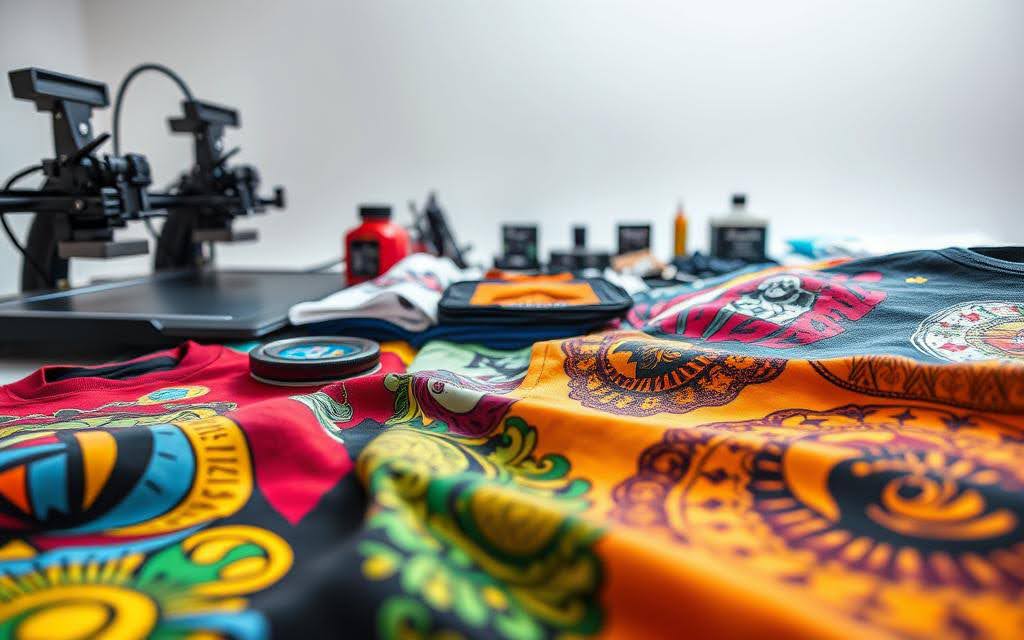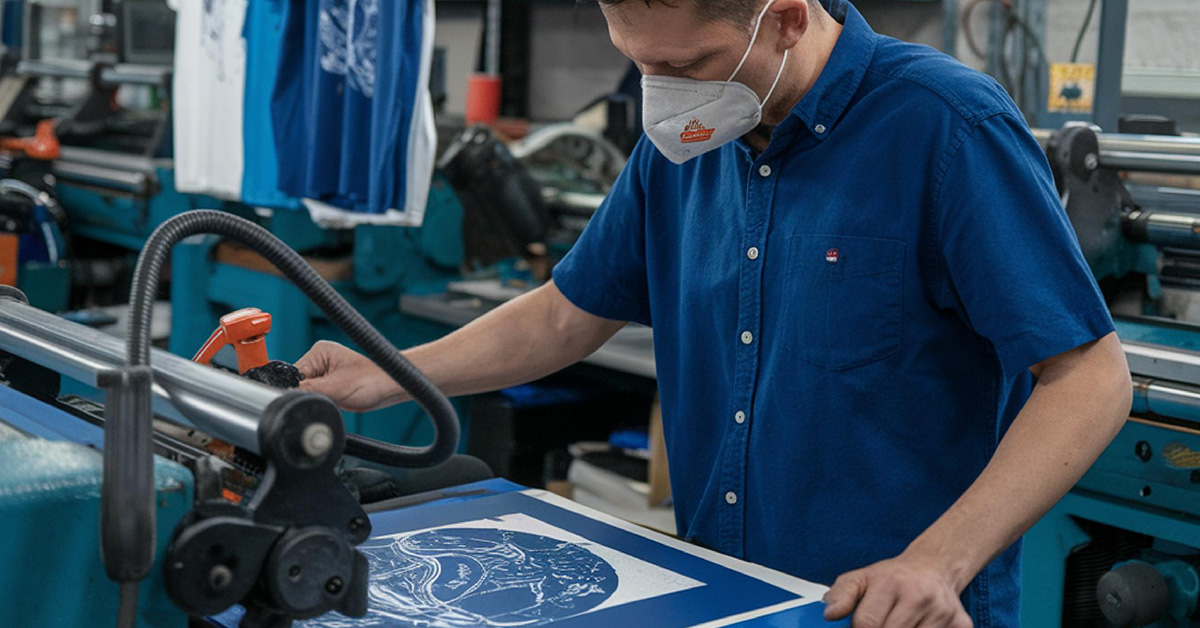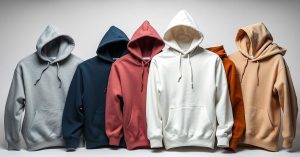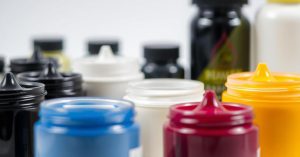Ever wondered why some t-shirts maintain their vibrant colors and crisp designs after countless washes, while others fade and crack after just a few wear cycles? In an era where fast fashion dominates the market, understanding what type of t shirt printing lasts the longest has become crucial for both consumers and businesses seeking sustainable, cost-effective solutions.
The answer isn’t straightforward. Different printing methods excel in various scenarios, and the longevity of your custom apparel depends on multiple factors including fabric type, ink quality, and care practices. This comprehensive guide explores the most durable t-shirt printing techniques available today, helping you make informed decisions whether you’re ordering custom shirts for your business or simply want clothing that stands the test of time.
Table of Contents
Understanding the Importance of Durable T-Shirt Printing
The Environmental Impact of Fast Fashion
The fast fashion industry has fundamentally transformed consumer behavior, creating a culture of disposable clothing that wreaks havoc on our environment. Statistics reveal that the average garment is worn only seven times before being discarded, contributing to the staggering 92 million tons of textile waste generated annually worldwide.
This unsustainable cycle has led to the emergence of the “30 Wear Benchmark”. A concept suggesting that each clothing item should be worn at least thirty times to justify its environmental footprint. When we consider durable t-shirt printing through this lens, we begin to understand that investing in quality isn’t just about personal satisfaction; it’s about making responsible choices that contribute to a more sustainable future.
Traditional textile production consumes enormous amounts of water, releases harmful chemicals into ecosystems, and generates significant carbon emissions throughout the supply chain. By choosing long-lasting printing methods and supporting brands that prioritize durability, consumers can actively participate in reducing fashion’s environmental impact.
Why Quality Matters in Custom T-Shirts
Beyond environmental considerations, quality custom t-shirts offer tangible benefits that extend far beyond their initial cost. Businesses investing in custom t shirt printing discover that durable garments serve as long-term marketing assets, maintaining brand visibility and professional appearance over extended periods.
For consumers, quality translates directly to value. A well-printed shirt that maintains its appearance after hundreds of washes ultimately costs less per wear than cheaper alternatives that require frequent replacement. Moreover, durable prints preserve the emotional and aesthetic value of custom designs, whether they commemorate special events, represent team affiliations, or express personal style.
The psychological impact shouldn’t be underestimated either. Clothing that maintains its quality over time builds confidence and satisfaction, while deteriorating garments can create frustration and disappointment. This is particularly important for businesses whose branded apparel represents their professional image and brand values.
Screen Printing: A Timeless Classic for Durability
How Screen Printing Works
Screen printing represents one of the oldest and most reliable methods for creating durable apparel graphics. This time-tested technique involves forcing thick layers of specially formulated ink through a fine mesh screen onto the fabric surface, creating prints that integrate deeply with the textile fibers.
The process begins with creating a stencil or screen for each color in the design. Artisans stretch fine mesh material across frames, then block specific areas to allow ink passage only where the design should appear. During printing, operators place the screen over the garment and use squeegees to push ink through the mesh, depositing controlled amounts directly onto the fabric.
What sets screen printing apart is its use of specialized plastisol or water-based inks that cure at high temperatures, creating a permanent bond with the fabric. Unlike other methods that sit on top of the material, properly executed screen printing actually penetrates the textile fibers, resulting in prints that become part of the garment rather than mere surface applications.
Screen Printing Advantages
The screen printing advantages become apparent when examining print longevity and visual impact. This method consistently produces the most durable results across various fabric types, particularly when applied to cotton and cotton-blend materials. The thick ink deposits create vibrant colors that resist fading, cracking, and peeling even after hundreds of wash cycles.
Professional screen printing operations can achieve remarkable precision, reproducing complex designs with sharp edges and consistent color saturation across large production runs. The technique’s versatility allows for special effects including metallic finishes, glow-in-the-dark inks, and textured applications that add dimensional elements to designs.
Cost-effectiveness emerges as another significant advantage, particularly for larger orders. Once screens are prepared, the per-unit cost decreases substantially with volume, making screen printing ideal for businesses, organizations, and events requiring multiple identical garments.
Screen Printing Benefits | Details |
Durability Rating | 9.5/10 – Lasts 50+ washes without significant fading |
Best Fabric Types | Cotton, cotton blends, some polyester materials |
Color Vibrancy | Excellent – thick ink deposits create rich, saturated colors |
Cost Efficiency | High for orders over 24 pieces |
Design Complexity | Good for bold designs, limited fine detail capability |

What Type of T-Shirt Printing Lasts the Longest? A Comprehensive Analysis
Comparing Durability Across Different Printing Methods
When evaluating what type of t shirt printing lasts the longest, we must consider multiple variables that influence print longevity. Scientific testing and real-world usage data consistently demonstrate that certain methods outperform others in specific applications, making the choice highly dependent on your particular needs and priorities.
Screen printing emerges as the clear winner for overall durability, particularly when applied to natural fiber fabrics. The thick ink layers and high-temperature curing process create prints that can withstand hundreds of wash cycles while maintaining their original appearance. Industry testing shows that quality screen-printed garments retain 90% of their original color intensity after 50 wash cycles.
Sublimation printing excels specifically with polyester fabrics, where the dye molecules actually become part of the fiber structure. This creates prints that are virtually permanent, resistant to fading, cracking, or peeling under normal use conditions. However, this method’s effectiveness is limited to synthetic materials and light-colored garments.
DTG printing offers excellent detail reproduction and unlimited color options but typically shows more wear over time compared to screen printing. Modern water-based inks and improved pre-treatment processes have significantly enhanced DTG durability, though results vary considerably based on equipment quality and operator expertise.
Factors Affecting Print Longevity
Understanding the variables that impact print durability helps consumers and businesses make informed decisions about their printing investments. The type of fabric plays a crucial role. Natural fibers like cotton generally accept and retain inks better than synthetic materials, though polyester works exceptionally well with specific printing methods like sublimation.
Ink quality represents perhaps the most critical factor in determining longevity. Premium inks contain higher concentrations of pigments and superior binding agents that resist degradation from washing, UV exposure, and normal wear. Professional printing operations invest significantly in quality inks because they understand that saving money on materials ultimately compromises the final product.
Care practices dramatically influence how long prints maintain their appearance. Washing in cold water, avoiding bleach, and air-drying or using low heat settings can extend print life substantially. Conversely, hot water, harsh detergents, and high-heat drying can accelerate deterioration even in the most durable prints.
Durability Comparison Chart | Screen Printing | DTG Printing | Heat Transfer | Sublimation |
Wash Resistance | Excellent (50+ cycles) | Good (30-40 cycles) | Fair (15-25 cycles) | Excellent (50+ cycles) |
Color Retention | 95% after 25 washes | 85% after 25 washes | 75% after 25 washes | 98% after 25 washes |
Cracking/Peeling Risk | Very Low | Low | Moderate | None |
Best Fabric Match | Cotton/Cotton Blends | Cotton | Various | 100% Polyester |
Direct-to-Garment (DTG) Printing: A Modern Approach
The Process of DTG Printing
Direct-to-garment printing represents a revolutionary advancement in textile decoration technology, utilizing modified inkjet printers to apply water-based inks directly onto fabric surfaces. This printing technique eliminates many traditional limitations, allowing for photographic quality reproductions and unlimited color palettes without setup costs or minimum order requirements.
The DTG printing process begins with digital file preparation, where designs are color-separated and optimized for textile application. Pre-treatment solutions are then applied to the garment to ensure proper ink absorption and color vibrancy, particularly important when printing on dark-colored fabrics.
During printing, the garment is positioned on a specialized platen system that holds it perfectly flat while print heads move across the surface, depositing precise amounts of ink according to the digital design. Multiple passes may be required for optimal color saturation, with white ink often applied as an underbase for designs on dark garments.
DTG vs. Traditional Methods: Which Lasts Longer?
Comparing DTG with traditional screen printing reveals distinct advantages and limitations for each method. DTG excels in reproducing photographic images, gradients, and designs with unlimited colors, making it ideal for artistic applications and small-batch custom work. The prints feel softer than screen printing because the thinner ink layers integrate more naturally with the fabric texture.
However, durability testing consistently shows that properly executed screen printing outlasts DTG applications. Screen printing’s thicker ink deposits and chemical curing process create more robust prints that resist washing and wear better over time. DTG prints, while initially vibrant and detailed, may show subtle fading or softening after extensive washing.
Recent advances in DTG technology, including improved inks and pre-treatment formulations, have narrowed this durability gap significantly. Modern DTG prints can achieve 80-90% of screen printing’s longevity while offering superior design flexibility and faster turnaround times for small orders.
Heat Transfer Printing: Versatility Meets Quick Production
Exploring Different Types of Heat Transfer
Heat transfer printing encompasses several distinct techniques, each offering unique advantages for specific applications. Vinyl printing utilizes cut vinyl films that are applied to garments using heat and pressure, creating durable graphics particularly effective for text, logos, and simple designs with solid colors.
Digital heat transfer methods involve printing designs onto special transfer papers using solvent or sublimation inks, then applying these transfers to garments through heat press operations. This approach enables full-color graphics and photographic reproductions while maintaining the quick turnaround advantages of transfer applications.
The versatility of heat transfer methods makes them particularly valuable for businesses requiring diverse graphics capabilities. A single heat press can accommodate various transfer types, allowing operators to switch between vinyl applications, digital transfers, and specialty materials based on customer requirements.
Heat Transfer Durability Compared to Other Methods
When examining t shirt printing methods pros and cons, heat transfer techniques occupy a middle ground between premium methods like screen printing and basic applications like iron-on transfers. Vinyl transfers, when properly applied with commercial-grade equipment and materials, can achieve durability comparable to screen printing for simple designs.
Digital heat transfers typically show less longevity than vinyl applications, particularly when subjected to frequent washing or harsh care conditions. However, their ability to reproduce complex, full-color graphics makes them valuable for applications where design complexity outweighs maximum durability requirements.
Professional heat transfer operations using quality materials and proper techniques can produce prints lasting 25-40 wash cycles while maintaining acceptable appearance standards. This makes heat transfer an excellent choice for promotional items, short-term campaigns, or situations requiring rapid production with moderate durability expectations.

Sublimation Printing: Best for Polyester and Detail
The Unique Process of Sublimation Printing
Sublimation printing operates on a fascinating scientific principle where solid dye particles transform directly into gas when heated, bypassing the liquid phase entirely. This dye sublimation process allows color molecules to penetrate deeply into polyester fibers, creating prints that become permanently integrated with the fabric structure.
The process utilizes special sublimation inks printed onto transfer papers using modified inkjet printers. When subjected to temperatures around 400°F under pressure, these inks vaporize and bond molecularly with polyester fibers, resulting in prints that cannot crack, peel, or fade through normal washing and wear.
Sublimation works exclusively with polyester fabrics or polyester-coated surfaces, as natural fibers lack the chemical structure necessary for dye molecule bonding. This limitation restricts sublimation’s applications but creates unmatched durability and vibrancy when properly applied to compatible materials.
Why Sublimation Is Extremely Durable
The molecular-level bonding achieved through sublimation creates the most permanent printing results possible in textile decoration. Unlike other methods where inks or materials are applied to fabric surfaces, sublimation literally becomes part of the fabric itself, making the prints as durable as the garment material.
When comparing sublimation vs embroidery, sublimation offers superior color reproduction and design detail while maintaining the fabric’s original hand-feel. Embroidered designs can add stiffness or bulk to garments, while sublimated graphics maintain the textile’s natural drape and comfort characteristics.
Testing demonstrates that sublimated prints retain their original color intensity and sharpness indefinitely under normal use conditions. The prints resist fading from UV exposure, show no degradation from washing with standard detergents, and maintain their appearance even after hundreds of wear and wash cycles.
Choosing the Right Method for Your Needs
Fabric Considerations and Method Selection
Selecting the optimal printing method requires careful consideration of fabric composition, intended use, and longevity expectations. Cotton and cotton-blend fabrics work exceptionally well with screen printing and DTG methods, while polyester materials achieve best results with sublimation techniques.
Understanding your embroidery fabric options expands decorating possibilities beyond printing methods. While embroidery offers excellent durability and perceived value, it works best for text, logos, and designs with limited color requirements. Combining embroidery with printing methods can create premium custom apparel that maximizes both visual impact and longevity.
The intended use environment significantly influences method selection. Garments subjected to frequent washing, such as work uniforms or sports team apparel, benefit from screen printing’s superior wash resistance. Promotional items or event merchandise with shorter intended lifespans may utilize more cost-effective methods like heat transfer or DTG printing.
Making the Best Investment Decision
Creating a successful custom apparel strategy requires balancing initial costs with long-term value considerations. While screen printing requires higher setup costs, the per-unit price decreases significantly with larger orders, making it ideal for bulk applications requiring maximum durability.
For businesses exploring various screen printing types, working with experienced professionals ensures optimal results. Water-based, plastisol, and specialty inks each offer distinct advantages depending on fabric type, design requirements, and intended use conditions.
Small businesses or individuals requiring limited quantities may find DTG or heat transfer methods more economical despite potentially shorter lifespans. The key lies in accurately assessing your specific needs and choosing methods that provide the best value proposition for your particular application.
Decision Matrix | Order Quantity | Design Complexity | Durability Priority | Recommended Method |
High Volume | 50+ pieces | Simple/Bold | Maximum | Screen Printing |
Medium Volume | 12-50 pieces | Moderate | High | DTG or Screen Printing |
Low Volume | 1-12 pieces | Any | Moderate | DTG or Heat Transfer |
Polyester Only | Any | Any | Maximum | Sublimation |
Finding the Perfect Balance for Long-Lasting Custom Apparel
Determining what type of t shirt printing lasts the longest requires understanding how different printing techniques perform across various fabrics and use conditions. After examining all major types of t-shirt printing methods, it’s clear that no single approach dominates every scenario. The best printing method depends entirely on your specific requirements and priorities.
Traditional screen printing remains the gold standard for durability, particularly when you need prints that stand the test of time through countless wash cycles. The thick layer of ink applied during screen printing creates vibrant graphics that resist fading, making it ideal for businesses investing in custom t-shirts as long-term marketing assets. When comparing different t-shirt printing methods, screen printing consistently outperforms alternatives in longevity tests.
For polyester garments, dye sublimation represents the longest-lasting t-shirt printing option available. The unique process that applies color directly onto the fabric fibers creates permanent bonds that will never crack, peel, or fade over time. This makes sublimation the best t-shirt printing method for athletic wear, promotional items, and any application where all-over printing is desired.
DTG printing offers the perfect compromise between detail reproduction and durability for smaller orders. While not quite as long-lasting as screen printing, modern DTG technology produces durable prints that satisfy most commercial applications. The ability to print t-shirts with photographic detail and unlimited colors makes DTG an excellent choice for custom printed shirts requiring complex graphics.
Heat transfer methods, including vinyl printing and DTF printing, provide valuable solutions for quick turnaround projects and variable data printing. Though these printing options may not achieve the extreme longevity of screen printing or sublimation, they offer excellent versatility and cost-effectiveness for specific applications.
The type of fabric you choose significantly impacts which shirt printing method will deliver optimal results. Cotton and cotton blends work exceptionally well with screen printing and DTG, while polyester fabrics achieve maximum durability with sublimation techniques. Understanding how each printing technique interacts with different materials ensures you select the right printing approach for your project.
When choosing the right printing method, consider not just initial costs but the total lifecycle value of your custom apparel. A durable t-shirt printing investment that maintains its appearance for years ultimately provides better value than cheaper alternatives requiring frequent replacement. Whether you need a single custom printed shirt or thousands of identical pieces, matching the printing method to your specific requirements ensures optimal results.
The future of t-shirt printing continues evolving with new technologies and improved materials, but the fundamental principles of durability remain constant. By understanding how each technique for printing performs and selecting methods that align with your fabric choice, design complexity, and longevity expectations, you can create custom t-shirts that deliver lasting satisfaction and value for years to come.





